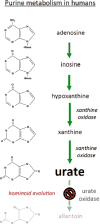Targeting urate to reduce oxidative stress in Parkinson disease
- PMID: 28622913
- PMCID: PMC5693633
- DOI: 10.1016/j.expneurol.2017.06.017
Targeting urate to reduce oxidative stress in Parkinson disease
Abstract
Oxidative stress has been implicated as a core contributor to the initiation and progression of multiple neurological diseases. Genetic and environmental factors can produce oxidative stress through mitochondrial dysfunction leading to the degeneration of dopaminergic and other neurons underlying Parkinson disease (PD). Although clinical trials of antioxidants have thus far failed to demonstrate slowed progression of PD, oxidative stress remains a compelling target. Rather than prompting abandonment of antioxidant strategies, these failures have raised the bar for justifying drug and dosing selections and for improving study designs to test for disease modification by antioxidants. Urate, the main antioxidant found in plasma as well as the end product of purine metabolism in humans, has emerged as a promising potential neuroprotectant with advantages that distinguish it from previously tested antioxidant agents. Uniquely, higher urate levels in plasma or cerebrospinal fluid (CSF) have been linked to both a lower risk of developing PD and to a slower rate of its subsequent progression in numerous large prospective epidemiological and clinical cohorts. Laboratory evidence that urate confers neuroprotection in cellular and animal models of PD, possibly via the Nrf2 antioxidant response pathway, further strengthened its candidacy for rapid clinical translation. An early phase trial of the urate precursor inosine demonstrated its capacity to safely produce well tolerated, long-term elevation of plasma and CSF urate in early PD, supporting a phase 3 trial now underway to determine whether oral inosine dosed to elevate urate to concentrations predictive of favorable prognosis in PD slows clinical decline in people with recently diagnosed, dopamine transporter-deficient PD.
Keywords: Antioxidant; Biomarker; Epidemiology; Mitochondrial dysfunction; Nrf2 activator neuroprotection; Oxidative stress; Parkinson disease; Urate; Uric acid.
Copyright © 2017 Elsevier Inc. All rights reserved.
Figures

References
-
- Burkhardt CR, Weber HK. Parkinson’s disease: a chronic, low-grade antioxidant deficiency? Med Hypotheses. 1994 Aug;43(2):111–14. - PubMed
Publication types
MeSH terms
Substances
Grants and funding
LinkOut - more resources
Full Text Sources
Other Literature Sources
Medical

